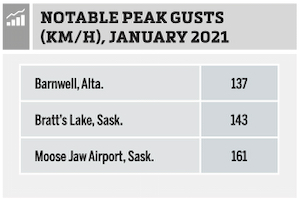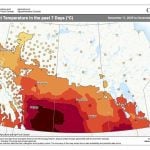In my last column we began our look at the top Canadian weather stories of 2021 and from the perspective of weather, what a year it was! The two top stories were the incredible heat wave that impacted a huge area of Western Canada in late June and early July and the devastating flooding that crippled parts of southern B.C. in November. Looking back at these two events, one could easily argue that not only were they Canada’s top weather stories, but also the top weather stories for the world, which is something we just don’t see happening in Canada.
Read Also

Farmer gift idea: How about a weather station?
The 2025 holiday season is looming, and a home weather station might make a great Christmas gift for farmers
This time we continue our look at the remaining top 10 weather stories of 2021 as listed by Environment Canada. I often don’t agree with the order of the weather stories, and sometimes I think that certain stories that don’t make the top 10 list should, but for this year, I think Environment Canada did a darned good job.
So, how do you follow up the first two big weather stories from last year? Well, the next top story was drought, and once again, it was centred over much of Western Canada, with southern Manitoba being particularly hard hit. I will be looking into the drought in more detail in upcoming issues as we approach the halfway point of winter, but despite a promising start to the winter it is not looking very good. The big question is, when do we start to panic just a little bit?
The drought has been around for a while now. Take Winnipeg, for example: it has now experienced its back-to-back driest years in over a century. The stage for a dry summer season was set last winter with very little snowfall, leaving most fields either bare or barely covered with snow. This allowed for an early and quick melt, which wouldn’t have been bad if we saw good spring rains, but those did not materialize. Start the summer off dry and then add heat waves and that spells disaster. At one point in late summer, 99 per cent of the Prairies was experiencing drought conditions. While areas did see some late-August rainfall that helped to salvage some crops, for the most part it was too little, much too late. As with the top two weather stories I could keep going, but we have more top stories to look at.
The next top story is directly tied to the last one: forest fires. If you spent any time outdoors on the Prairies last summer, you know there were fires raging somewhere. With the extremely dry conditions fires were inevitable. While the wildfires kept many people from exploring the outdoors and many communities had to be evacuated, the big cities well away from the fires also suffered from the smoke. Calgary reported 512 hours of smoke compared to an average of 12 hours. Edmonton fared better with 125 hours of smoke, still its second-smokiest summer since 1953. In Saskatchewan, Regina reported 147 hours of smoke, which was the third-highest amount in 70 years. Finally in Manitoba, Winnipeg reported 256 hours of smoke, its second most since 1953 and 16 times the average, according to Environment Canada.
The fifth top story of 2021 will sound like a bit of a broken record, but it was the heat. Not only did we see one heat wave, but they just seemed to keep coming. Edmonton recorded more hot days in 2021 than the previous eight years combined. Saskatoon topped 40 C in early July, and Winnipeg recorded 35 days with daytime highs above 30 C, which broke a record for the city. While Eastern Canada struggled to see any warm temperatures in July, as the West cooled in August the heat moved into the East. Montreal recorded its warmest August on record with records going back to 1871. The heat was particularly bad at night, with Toronto experiencing 14 nights where temperatures did not drop below 20 C; this compares to an average of four nights.
Still the north
 The last two stories I have room for seem to fly in the face of all the other weather stories: an extreme February cold snap and a late-January snowstorm. After making it through much of last winter unscathed by cold weather, Mother Nature had to remind everyone that we live in the north and cold weather in winter is always not that far away. Starting around the second week of February and lasting for almost two weeks, a blast of arctic air spilled southward across the Prairies. Temperatures dropped into the -40 C range in several locations, with Edmonton coming just shy of its all-time record low with a reading of -43.8 C on Feb. 7. Winnipeg saw temperatures fall to a bone-chilling -38.8 C on Feb. 13 and experienced nine days in a row where daytime highs did not make it above -22 C. Canada also saw the coldest temperature in four years when the temperature at Wekweètì, N.W.T. fell to -51.9 C.
The last two stories I have room for seem to fly in the face of all the other weather stories: an extreme February cold snap and a late-January snowstorm. After making it through much of last winter unscathed by cold weather, Mother Nature had to remind everyone that we live in the north and cold weather in winter is always not that far away. Starting around the second week of February and lasting for almost two weeks, a blast of arctic air spilled southward across the Prairies. Temperatures dropped into the -40 C range in several locations, with Edmonton coming just shy of its all-time record low with a reading of -43.8 C on Feb. 7. Winnipeg saw temperatures fall to a bone-chilling -38.8 C on Feb. 13 and experienced nine days in a row where daytime highs did not make it above -22 C. Canada also saw the coldest temperature in four years when the temperature at Wekweètì, N.W.T. fell to -51.9 C.
Just a few weeks before this, after a fairly quiet winter, an intense storm system brought rain, freezing rain, and then snow and blowing snow to a large area of Alberta and Saskatchewan. While the storm didn’t produce huge amounts of snow, it did pack wind gusts in excess of 100 km/h which were reported at over 74 weather stations, including those seen in the table.
















